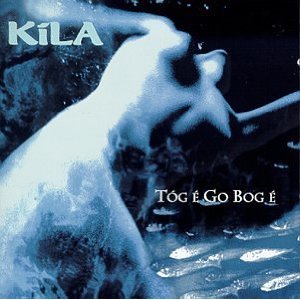 I’ve had this particular album sitting on my shelf and in my CD player for several months now. This is a lot longer than I usually let things sit, but it couldn’t be helped. You see, I couldn’t write any other reviews until I took care of this one, and I just couldn’t figure out what to say about Kila’s new release, Tog E Go Bog E.
I’ve had this particular album sitting on my shelf and in my CD player for several months now. This is a lot longer than I usually let things sit, but it couldn’t be helped. You see, I couldn’t write any other reviews until I took care of this one, and I just couldn’t figure out what to say about Kila’s new release, Tog E Go Bog E.
Mind you, that’s not because it’s bad. In fact, I’ve enjoyed this album a great deal, and I must have listened to it at least a dozen times by now, letting it run in the background as I mulled over just how to phrase the review. It’s not easy, let me tell you. Tog, as I call it for short, is a fascinatingly mixed bag of talented music that seems to encompass a wide range of what the Celtic world has to offer.
When I was offered this album, it was described as “Feral Irish” to me. [Editors note: Dirty Linen in a review of Mind the Gap (their first album ) that Kila was “a more feral Moving Hearts.” One must admit that it is a catchy phrase.] That alone left me puzzling over the meaning for hours. You hear the word feral, and what comes to mind? Formerly domesticated animals, gone wild, but possessing all of the intelligence and knowledge they picked up when they still associated with civilization. Feral implies dangerous, and alien, set apart from society but not completely different. Tarzan’s a feral kind of creature, going by that image. So here I was, envisioning a group of wild-eyed, tooth-gnashing Irishmen who’d wandered away from civilization, and were now playing music on the outskirts of society.
Okay, so I’m exaggerating. But the fact is, Tog E Go Bog E really is quite alien to what the average person is used to. For one thing, don’t expect to actually understand the words. All of the songs are either instrumentals, or sung in Gaelic, thus reducing the possibility that you’ll understand what’s being said. Only one song “Tip Toe” is sung in English; and by that point, after listening to the rest of the album, you might very well mistake it for Gaelic.
How’s the music, you ask? Beautiful. Fluid. Haunting. Each song is different from the last. Bodhran, bouzaki, whistles, congas, flute, fiddle, dulcimer, guitar, saxophone, bagpipes, accordeon, cymbals, ulilleann pipes and more weave together from song to song in a rich and varied tapestry. One song might be nothing but a solo for the ulilleann pipes, the next a spotlight on the bagpipes, the next a capella, and then all of a sudden, a dozen instruments at once will explode into a celebration of harmony.
Kila is made up of seven core musicians: Ronan O Snodaigh, Rossa O Snodaigh, Colm O Snodaigh, Eoin Dillon, Dee Armstrong, Lance Hogan, and Brian Hogan. Between them, they manage to field all of the instruments listed above and several more to boot, not to mention vocals as appropriate. For this album, they were joined by several other musicians, including Breda Mayock (fiddle), Hugh O’ Neill (trumpet), and Pete Ruotolo (electric guitar). The group, as a whole, is a greatly talented one.
Luckily, the liner notes are remarkably thorough, listing who did what for each song, and giving the lyrics (in Gaelic) for the songs that had a vocal component. The English translations of the songs and more information about Kila can be found at Kila’s Web site.
Overall, I really enjoyed this album. Some songs fell flat, like the a capella song “Bi Ann,” which was hard to enjoy because I couldn’t understand the lyrics. However, the songs that took full advantage of Kila’s instrumental talents, like “Dusty Wine Bottle,” “Oh To Kiss Katie” or even the unusual “Siege of Carrickfinn National Airport” truly caught my attention.
Kila flies in Tog E Go Bog E. Not always smoothly, but they do manage to catch the air and soar quite high in this endeavor. They’re worth paying attention to. True, you might not know what to make of them at first, but in this case, any effort expended in trying to understand is indeed rewarded.
